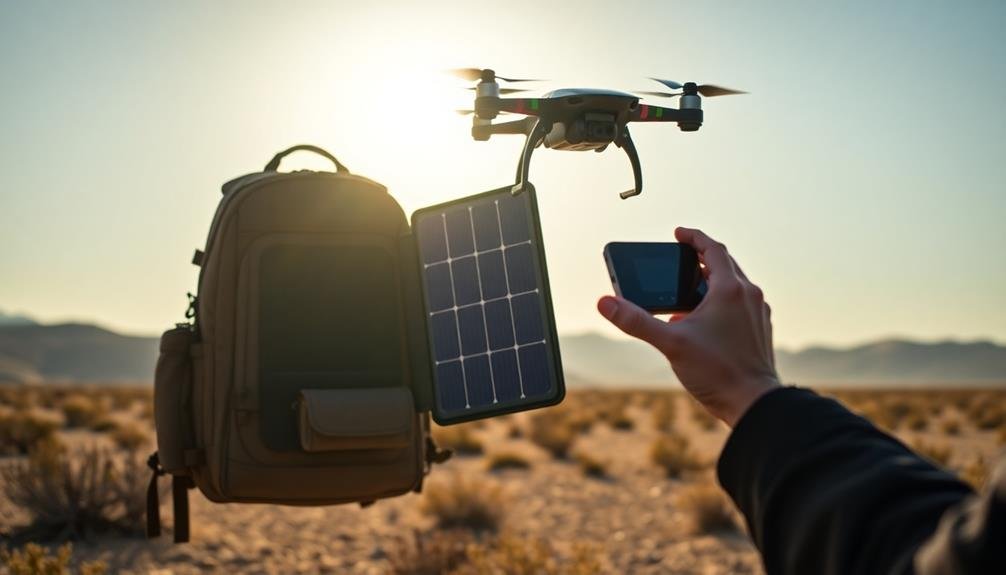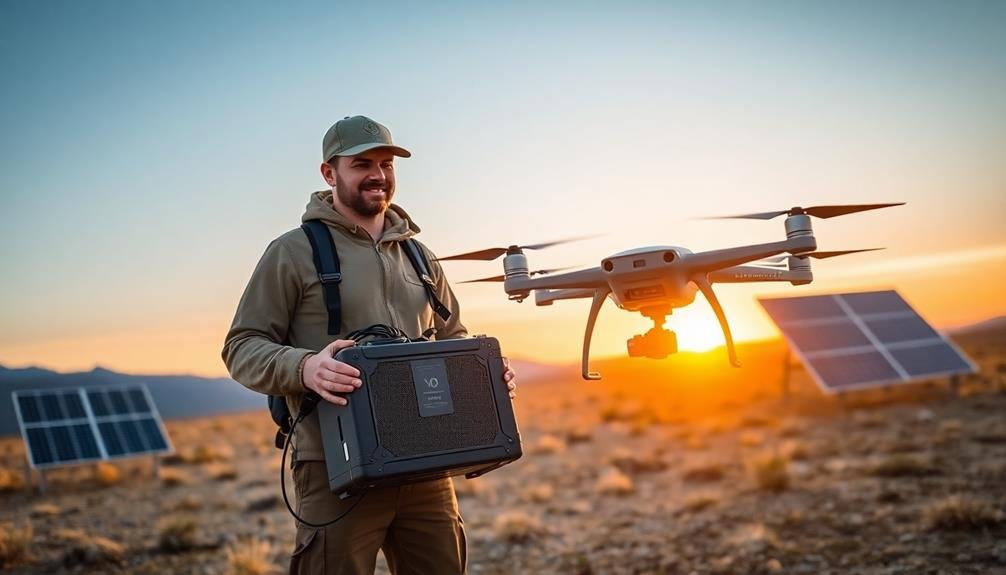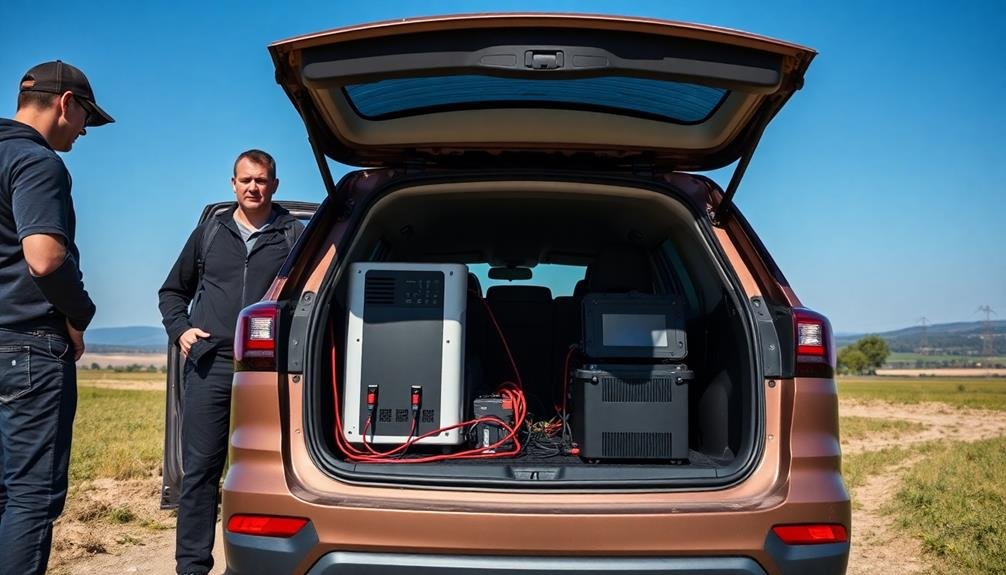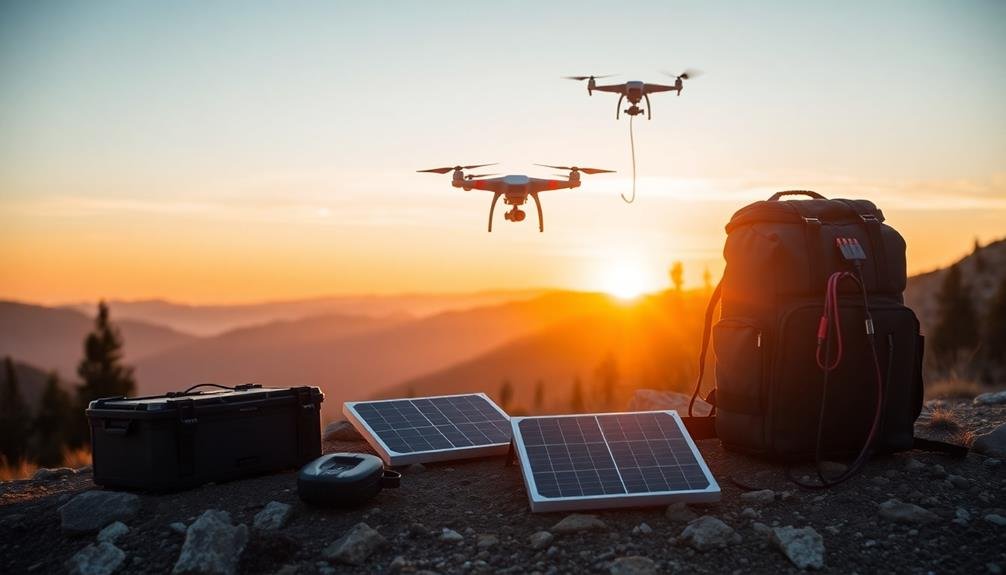For UAV operators on the move, three essential power solutions can keep your drones flying. Solar-powered charging stations offer sustainable energy with compact, foldable panels and versatile charging ports. High-capacity portable battery banks provide reliable power, ranging from 20,000mAh to 100,000mAh, with some featuring solar inputs for field recharging. Vehicle-based power inverters convert your car's 12V DC to 110V AC, offering wattages up to 3000W for powering UAV equipment. Each option has unique benefits, from eco-friendly solar power to high-capacity storage and vehicle integration. Exploring these solutions can greatly enhance your UAV operations in remote locations.
Key Takeaways
- Solar-powered charging stations provide sustainable power with compact, portable units featuring foldable panels and multiple charging options.
- High-capacity portable battery banks offer reliable energy for extended UAV operations, with capacities ranging from 20,000mAh to 100,000mAh.
- Vehicle-based power inverters convert 12V DC to 110V AC, enabling UAV equipment charging from a vehicle with various wattage options.
- Solar charging stations and battery banks are ideal for remote locations, while vehicle inverters suit operators with consistent vehicle access.
- Consider factors like weight, size, charging speed, and power output when selecting the most suitable on-the-go power solution for UAV operations.
Solar-Powered Charging Stations

Harnessing the sun's energy, solar-powered charging stations offer UAV operators a sustainable and portable power solution. These compact units typically consist of foldable solar panels, a battery pack, and various charging ports.
You'll find they're lightweight and easy to transport, making them ideal for remote operations. When you're in the field, simply unfold the solar panels and position them towards the sun. They'll convert sunlight into electricity, storing it in the built-in battery.
Many models feature USB ports, DC outputs, and even AC inverters, allowing you to charge multiple devices simultaneously. You'll appreciate the eco-friendly nature of these charging stations, as they reduce your reliance on fossil fuels.
They're particularly useful in areas without access to grid power. Some advanced models even come with MPPT (Maximum Power Point Tracking) technology, optimizing power conversion efficiency.
To maximize their effectiveness, you should consider the wattage output and battery capacity when selecting a solar charging station. Higher wattage panels will charge your devices faster, while larger battery capacities provide more stored power for cloudy days or nighttime use.
High-Capacity Portable Battery Banks

Powering up your UAV operations, high-capacity portable battery banks offer a reliable and versatile energy solution.
These compact powerhouses can keep your drones and equipment running for extended periods, even in remote locations. You'll find a range of options on the market, from 20,000mAh units suitable for smaller drones to massive 100,000mAh banks capable of supporting multiple devices and larger UAVs.
When choosing a battery bank, consider factors like weight, size, and charging speed. Look for models with multiple output ports, including USB-C for fast charging.
Some advanced units feature solar panel inputs, allowing you to recharge them in the field. Don't forget to check for aviation-safe certifications if you plan to travel with your battery bank.
To maximize efficiency, invest in a bank with pass-through charging capabilities. This feature lets you charge both the battery and your devices simultaneously.
Remember to monitor your bank's temperature and avoid exposing it to extreme conditions. With proper care and regular maintenance, a high-quality portable battery bank can be a game-changer for your UAV operations, ensuring you're always powered up and ready to fly.
Vehicle-Based Power Inverters

While portable battery banks offer great mobility, vehicle-based power inverters provide a constant and robust power source for your UAV operations. These devices convert your vehicle's 12V DC power into 110V AC power, allowing you to charge and operate various UAV equipment directly from your car or truck.
You'll find inverters in different wattage capacities, typically ranging from 150W to 3000W. For most UAV needs, a 1000W inverter should suffice. When choosing an inverter, consider your power requirements and verify it can handle the combined wattage of all devices you'll connect simultaneously.
Installation is straightforward: you'll connect the inverter directly to your vehicle's battery using heavy-gauge wires. Some models plug into your car's 12V outlet, but these are usually limited to lower wattages.
Key features to look for include overload protection, low battery shutdown, and cooling fans. Pure sine wave inverters offer cleaner power and are ideal for sensitive electronics, while modified sine wave inverters are more affordable but may not be suitable for all devices.
Remember to keep your vehicle running while using the inverter to prevent draining the battery. This solution guarantees you'll have a reliable power source for extended UAV missions in remote locations.
Frequently Asked Questions
How Do Weather Conditions Affect the Efficiency of UAV Power Solutions?
Weather conditions greatly impact your UAV power solutions' efficiency. Cold temperatures reduce battery life, while heat can cause overheating. Wind affects flight time and power consumption. Rain and humidity may damage electrical components. You'll need to adapt accordingly.
Are There Weight Restrictions for Carrying Portable Power Solutions on Commercial Flights?
You'll face restrictions when flying with portable power solutions. Airlines typically limit lithium batteries to 100Wh in carry-on luggage. For larger capacities, you'll need airline approval. Always check specific airline policies before traveling.
What Safety Precautions Should Be Taken When Using Lithium-Ion Batteries for UAVS?
When using lithium-ion batteries for UAVs, you'll need to handle them carefully. Don't overcharge or puncture them. Store in fire-resistant containers. Avoid extreme temperatures. Inspect regularly for damage. Follow manufacturer guidelines. Always have a fire extinguisher nearby.
Can Multiple UAVS Be Charged Simultaneously Using a Single Power Solution?
Yes, you can charge multiple UAVs simultaneously using a single power solution. You'll need a multi-port charger or power bank with sufficient output. It's efficient, but you must ascertain the charger can handle the combined power requirements.
How Do Different Terrains Impact the Performance of On-The-Go Power Solutions?
You'll find that terrain greatly affects power solutions. Rocky areas can damage equipment, while sandy environments may clog systems. Wet conditions pose electrical risks, and extreme temperatures impact battery efficiency. Always adapt your setup to the environment.
In Summary
You've now got three solid options for keeping your UAVs powered up in the field. Whether you're harnessing the sun's energy, relying on high-capacity portable batteries, or tapping into your vehicle's power, you'll be able to extend your flight time and operational range. Don't let power limitations hold you back. With these on-the-go solutions, you're ready to tackle any mission, no matter how remote or challenging the location may be.

As educators and advocates for responsible drone use, we’re committed to sharing our knowledge and expertise with aspiring aerial photographers.




Leave a Reply